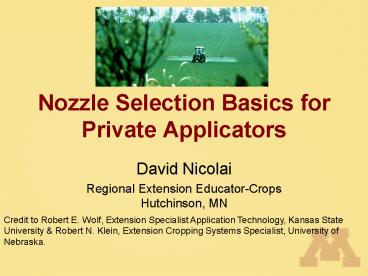Nozzle Selection Basics for Private Applicators PowerPoint PPT Presentation
1 / 21
Title: Nozzle Selection Basics for Private Applicators
1
Nozzle Selection Basics for Private Applicators
- David Nicolai
- Regional Extension Educator-Crops Hutchinson, MN
Credit to Robert E. Wolf, Extension Specialist
Application Technology, Kansas State University
Robert N. Klein, Extension Cropping Systems
Specialist, University of Nebraska.
2
Regardless of the status of existing nozzles
consider that
- Without proper attention to the nozzle, you may
end up with a misapplication
3
Nozzles are important to the Private Applicator
because they
- Control the amount GPA.
- Determine uniformity of application.
- Affects the coverage.
- Influences the drift potential.
4
Broadcast Crop Spray Nozzle choices are numerous
but often are targeted to a specific crop canopy,
pest or drift mgt situation.Which one is the
best?
- Flat Spray Tips
- Extended Range Flat-fan
- Drift Reduction Flat-fan
- Turbo Flood Flat-fan
- Turbo Flat-fan
- AI Flat-fan
- TurboDrop
5
What Coverage is Needed?
- Need knowledge of the product being used.
- Systemic
- Contact
- What is the target?
- Soil
- Grass
- Broadleaf (smooth, hairy, waxy)
- Leaf orientation time of day
- Disease prevention
- Insect
6
Selecting the proper nozzle
- Legal issues!!
- Following the label!
Refer to the label and nozzle manufactures
catalog for initial guidance
7
Nozzle Selection Basics
- What is the first step?
- Use label to select the
- application volume
- product rate
- Choose an appropriate travel speed
- Effective width of application
- nozzle spacing
- Calculate GPM Flow rate per nozzle
- Select the correct size of nozzle!
8
Flow Rate Equation
GPA x MPH x W
GPM
5940
- Calculates for amount of flow from one nozzle
- Represents the size of nozzle to put on the
sprayer
9
GPM Example Solution
GPA x MPH x W
GPM
5940
12 x 12 x 20
GPM
5940
0.48
Answer
10
Selecting the proper nozzle.
GPA
- Calculate GPM (formula)
- Look under GPM column
- Match to pressure-psi
- Choose the size needed
- Operate at given pressure and speed used in
formula to achieve GPA
0.48
11
Factors that control the Amount applied
- Nozzle Flow Rate is affected by
- Orifice size
- Pressure
- Solution characteristics
12
Typical Nozzle Numbering System Example
Extended Range
Trade Name
(S,H,P,K,SS)
Stainless Steel Insert Orifice
VisiFlo Color Coding
Fan angle and flow rate-orifice size(110 degree
angle at .04 GPM)
Rated Pressure
40 psi for most nozzle types 10 psi for turbo
flood nozzles
13
Consider drift potential when selecting nozzles
because
- Spotty pest control
- Wasted chemicals
- Off-target damage
- More high value specialty crops
- Urban sprawl and.....
- Less tolerant neighbors
- Litigious Society
- Organic Certification requires fields to be
pesticide-free for 3 years - Environmental impact
- Public more aware of pesticide
- concerns! (Negative) (Perceptions)
- Result-higher costs-
14
Factors Affecting Drift
- Spray Characteristics
- chemical
- formulation
- drop size
- evaporation
- Equipment Application
- nozzle type
- nozzle size
- nozzle pressure
- height of release
- Weather
- air movement (direction and velocity)
- temperature and humidity
- air stability/inversions
- topography
15
Nozzle Droplet size measured in microns
VMD
(Volume Median Diameter)
One micron (?m) 1/25,000 inch
(average human hair 90 ?m)
16
1/2 of spray volume smaller droplets 1/2 of
spray volume larger droplets
VMD
Volume Median Diameter is defined as 50 of the
volume of the spray is smaller than the size
shown
17
Efficacy and Drift Mitigation
- Size of the Spray Droplets - Microns
- Volume Median Diameter (VMD)
- Droplet Spectrum (Range - big to small)
Volume in droplets less than 200 microns in
size are highly driftable.
18
Effect of Droplet Discharge Height and Wind
Velocity on Drift Distances of Various Size
Droplets Discharged Downward at 44 mphH.E. Ozkan
Ohio State
Droplet completely evaporated before deposition
19
lt150
151-250
251-350
351-450
451-550
gt551
Source Crop Life July 2002
20
Spraying Systems Droplet Size in Microns
Category Very Fine Fine Medium Coarse Very
Coarse Extensively Coarse
?m size range 153 and less 154 241 242 -
358 359 - 451 452 - 740 741
Spray System Fungicides just into this
class Non-Translocated Herbicides Translocated
Herbicides Preplant, Preemergence Herbicides
21
In Conclusion
Minimizing spray drift is in the best interests
of everyone. Do your part to keep applications
on target.

